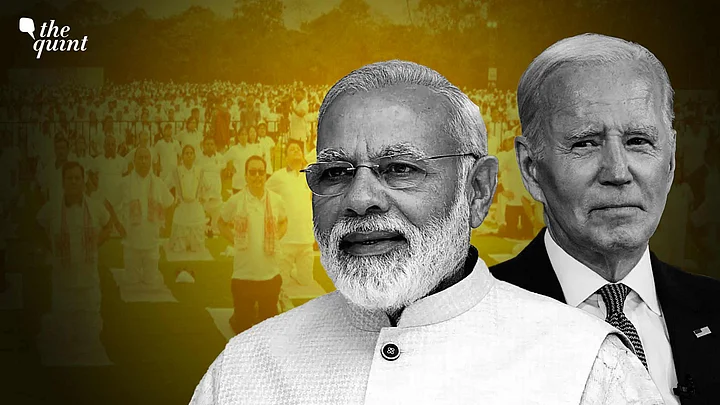Prime Minister Narendra Modi’s visit to the United States is not only about meeting President Joe Biden and his officials, addressing the US Congress, or working out technology deals which will be done mainly on 22 June. An important part of the US visit has been about what is called "soft power.”
Power and influence of the country are not merely a sum total of its GDP and military might, "soft power” plays a significant role in the ways a country exercises its influence and Indian prime ministers have been acutely aware of its importance, especially when visiting a country like the US.
This is what Modi’s participation at the 9th International Yoga Day at the United Nations in New York on 21 June, Wednesday has been all about. He skillfully used the occasion to link it to another important aspect of Indian soft power—its participation in United Nations Peacekeeping Operations.
It was on Modi's suggestion in 2015 that a new memorial to UN Peacekeepers was built at the UN headquarters. On Wednesday, he paid tribute at the memorial in New York. India, as he pointed out, is also the largest troop-contributing nation to the UN Peace Keeping Operations.
India’s Soft Power Outreach
As for yoga, the Prime Minister ensured that he distanced it from any religious symbolism linked to Hinduism, he declared that "Yoga is free from copyright, free from patents and free from royalty patents.”
India is acutely aware of the enormous soft power advantages it has in the US on account of its huge diaspora. In 2014, Modi began his first visit to the US with a massive rally at the iconic Madison Square Garden in New York. This was his first visit as the Prime Minister after the US lifted a visa ban that had been imposed on him on account of the Gujarat riots of 2002.
This was a massive personal rebranding exercise, and Washington which he was due to visit thereafter could not have missed the signal—that the Indian diaspora was big, it was influential and it was hugely behind Modi.
So, this time, along with the Yoga and the ceremonial aspects of the visit, Modi has sought to emphasise the importance of the diaspora through another angle—a special event on 21 June with First Lady Jill Biden on skill development.
At first sight, this may appear out of place in an event in the US, but it is linked to the fact that Indian skills and abilities form an important part of the larger US goal of reorienting its supply lines from China.
At the event, Modi highlighted the many steps taken by India to promote education, skilling, and innovation. The aim of the exercise was to enhance India-US cooperation and collaborations in the field of promoting vocational skills as well as education in general.
Partnership in Innovation
The White House Fact Sheet on the Initiative on Critical and Emerging Technology (iCET) which was finalised in January by Ajit Doval and his American counterpart Jake Sullivan had outlined the scope of the emerging Indian-American technology partnership. It listed a range of areas such as collaboration by research agencies of the two countries, defence innovation, and technology cooperation, creating resilient semiconductor supply chains, space, next-generation telecom, and so on.
But one of the areas that has not excited that much comment, the area of Science, Technology and Math (STEM) talent. This is through a new joint task force of the Association of American Universities and leading Indian educational institutions like the IITS which will seek to expand US-India research and higher education partnerships. As is well known, the US is a major beneficiary of Indian researchers and scholars migrating abroad.
The Biden-Harris Administration’s National Security Strategy released in October 2022, declared that "attracting a higher volume of global STEM talent is a priority for our national security and supply chain security." As the NSS document noted, the US views the ability to attract and retain global talent as one of America’s "asymmetric strategic advantages”.
On Student Visa
The US has been a major destination for students, especially those in the STEM field. The massive number of students have helped many universities to stay afloat. The ever-increasing number of Chinese students played an important role in providing STEM talent to the US. But US-China tensions have led to a ban on a number of students believed to have ties with the Chinese military.
In addition, visa duration for Chinese students studying subjects like Aviation and Robotics was shortened.
Even so, in 2022, there were about 290,000 Chinese students studying in the US, still the largest set of international students, but it was an 8.6 per cent decline over the previous year, by comparison, Indian students approached 200,000 last year, a 19 per cent increase on the year before.
The visit has, therefore, featured not only meetings with CEOs and business leaders who may invest in India, but also leading health experts, think tankers, eminent academics as well as personalities like Professor Paul Romer, an economist and policy entrepreneur, Neil de Grasse Tyson the physicist and author, Roy Thurman, a Buddhist scholar, the Nasim Nicholas Taleb, a public intellectual, and singers Falguni Shah and Mary Millben.
Incidentally, where in 2014 Modi began with a spectacular diaspora event, this time around, he will address the diaspora at the end of the visit on Thursday. This will be an address to the meeting of the diaspora at the Ronald Reagan Center in Washington DC.
(The writer is a Distinguished Fellow, Observer Research Foundation, New Delhi. This is an opinion article and the views expressed above are the author’s own. The Quint neither endorses nor is responsible for them.)
